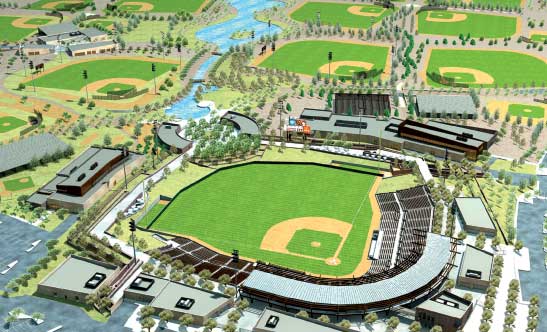With football, hockey, baseball and possibly USA Basketball joining the mix, the West Valley is becoming an active sports mecca for the rest of the Valley. Recent additions to this bustling hub of game activity are new Cactus League training facilities in Glendale and Goodyear that will come online for the 2009 spring training season.
This year, the Cactus League set a record when 1.3 million fans (60 percent from out of state) attended spring training games. The Cactus League’s contribution to the state’s economy is more than $200 million a year.
“Spring training is a big draw and a great experience,” says J.P. de la Montaigne, Cactus League president. “We call it our Super Bowl every year.”
Glendale’s new facility will be the spring training complex for the Los Angeles Dodgers and Chicago White Sox. The state-of-the-art baseball stadium will have seating for 13,000, four major league practice fields, eight minor league practice fields, two practice infields and 118,000 square feet of major and minor league clubhouses for the two teams. Down the road, the 151-acre site will also have residential, restaurant and retail development, a four-star hotel and an 18-hole golf course developed by Rightpath Limited Development Group.
The Arizona Sports & Tourism Authority is funding two-thirds of the complex, and the city of Glendale is contributing one-third of the $90 million project, which is under construction on 111th Avenue west of the Loop 101 between Camelback Road and Glendale Avenue. Stadium construction started in November 2007 and will be finished in time for the 2009 spring training season.
Tom Harrison, construction executive for Mortenson Sports, a division of Mortenson Construction which is building the complex, says planning the facility took longer than anticipated, so they added a night shift in August to keep construction on schedule.
“This is an exciting project and we have the right team to get it accomplished on time,” Harrison says. “I’ve been involved in five other spring training facilities in the Valley, but this is truly the most unique. The Glendale facility will be more than just a place to watch the game.”
Harrison says the Glendale stadium will have a 1,400-foot-long lake as part of the facility. The lake will have an aesthetic function as well as serve as the irrigation source for the lush landscaping that will create a park-like setting at the stadium.
“This is not going to be a standard practice area,” Harrison says. “It’s going to be an aesthetically pleasing setting with benches so fans can enjoy their surroundings.”
Based on a 2006 economic impact study conducted by Economic Research Associates for the city of Glendale, the economic impact of moving the Dodgers and White Sox to Glendale could be as much as $19 million per year for the region.
“The new spring training facility fits well in our sports and entertainment district,” says Jennifer Liewer, senior marketing and communications manager for the city of Glendale. “The Dodgers and White Sox want to make this something that will last and be part of the community, so we know that when they get to Glendale it will become their home as well.”
The Cleveland Indians and Cincinnati Reds will play at the Goodyear Ballpark, which will be located on a 3-acre parcel south of Yuma Road and east of Estrella Parkway. The ballpark will open in March 2009 for spring training for the Indians. The Cincinnati Reds will move their spring training operations to Arizona in 2010.
HOK Sport of Kansas City designed the baseball complex, which will have 8,000 lower-bowl fixed seats, 500 premium seats, 1,400 berm seats, six luxury suites, 3,000 parking spaces, and a state-of-the-art scoreboard and public address system. It will also have two group event areas: an outfield pavilion and bar with berm seating for 400 and a third-floor party deck behind home plate that will hold 150 people. Barton Marlow, a national construction services company out of Michigan, is building the ballpark complex.
The Goodyear Recreational Sports Complex, which will house the Cleveland Indians’ clubhouse/player development facility and two practice fields, is under construction on a 52-acre site east of Estrella Parkway about a half-mile south of the Goodyear Ballpark. It will be completed this month, at which time the Indians will begin using it. The Indians will use the clubhouse and two practice fields year-round. Besides the clubhouse, the Goodyear Recreational Sports Complex has six full-baseball practice fields, two half-baseball practice fields, a 36,000 square foot agility field, six covered practice batting cages and tunnels, three open practice minor league batting tunnels, six pitching mounds for the major league and six for minor league, an observation tower for the major league fields and a scoreboard.
Goodyear citizens approved a bond election in 2004 for $10 million to help build the recreational sports fields, so the city will be able to use the four minor league fields 10 months of the year. Regis Reed, Goodyear’s senior project manager, says the city plans to use the fields for city events, youth programsand high school tournaments since the fields are lighted to high school standards.
Ticket prices at the Goodyear Ballpark will be comparable to other Cactus League facilities, which are $8 for a lawn seat and up to $27 for a club or premium seat.
Nathan Torres, stadium manager for the Goodyear Recreational Sports Complex, says that based on a 2007 Cactus League survey, the economic impact of the Cleveland Indians moving to Arizona in 2009 will be more than $23 million. That number will grow to more than $47 million when the Cincinnati Reds are introduced in 2010.




